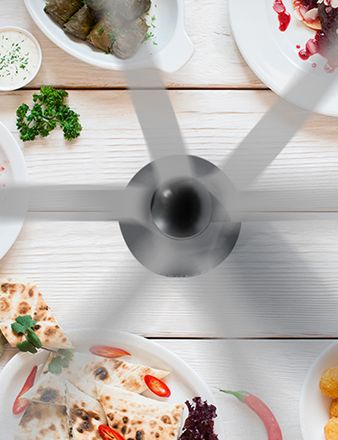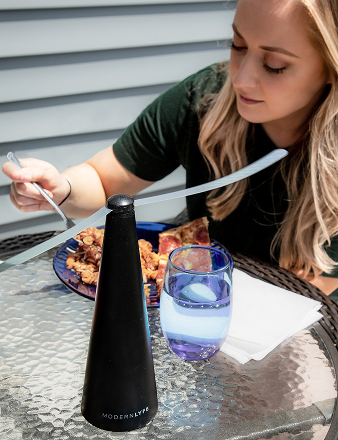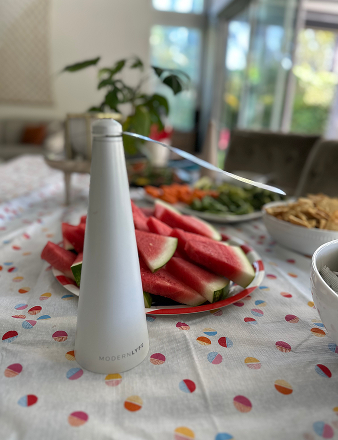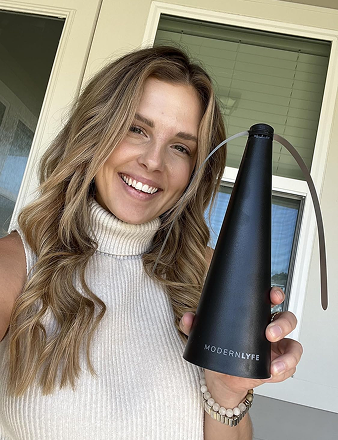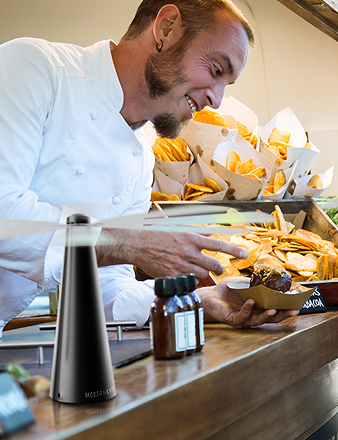So, do fly fans actually work? Let's cut to the chase: yes, they absolutely do. If you've ever had a great outdoor meal spoiled by a swarm of flies, you’ll be happy to know there's a simple, effective way to create a pest-free zone.
The Science of a Simple Breeze
A fly fan is one of those brilliantly simple inventions that makes you wonder why you didn't think of it first. It doesn’t use chemicals or loud zappers. Instead, it works by outsmarting a fly's basic biology to create an invisible shield over your table.
The device creates a gentle but steady breeze that flies find impossible to navigate. For a tiny insect, this constant airflow is like trying to land a small plane in a hurricane. It's too chaotic for them to fly through, so they steer clear. This aerodynamic barrier is the main reason fly fans get the job done.
But there's another clever trick at play.
The spinning blades on most fly fans have holographic patterns. As they rotate, they refract light in a way that messes with a fly’s vision. To their compound eyes, this shimmering, erratic light signals danger, triggering their natural instinct to get away—fast.
This one-two punch of wind and light is what makes these devices so effective. Many of the most popular brands offer 100% chemical-free fans that are completely safe to use around food, kids, and pets. You can see how these non-toxic solutions are changing the game by checking out the rise of fly fans.
It's this combination that makes them perfect for:
- Backyard barbecues
- Restaurant patios
- Camping trips
- Any time you're eating outside
Simply put, fly fans create an environment flies can't stand. The table below breaks down the two key ways they keep your space clear.
How Fly Fans Keep Pests Away
A quick summary of the two main ways fly fans effectively repel flies, making your outdoor spaces more enjoyable.
| Mechanism | How It Works | Primary Benefit |
|---|---|---|
| Aerodynamic Disruption | The fan creates a gentle, consistent air current that is too turbulent for small insects like flies to navigate. | Flies are physically unable to land near the fan, keeping them off your food and out of your space. |
| Visual Confusion | Reflective, holographic patterns on the blades scatter light, which confuses and alarms a fly's compound eyes. | This visual "threat" triggers a fly's natural instinct to avoid the area entirely. |
Ultimately, a fly fan uses a fly's own senses against it. The constant breeze makes flying a nightmare and the flashing lights signal danger, creating a powerful, pest-free bubble right where you need it.
The Science Behind a Fly-Free Zone
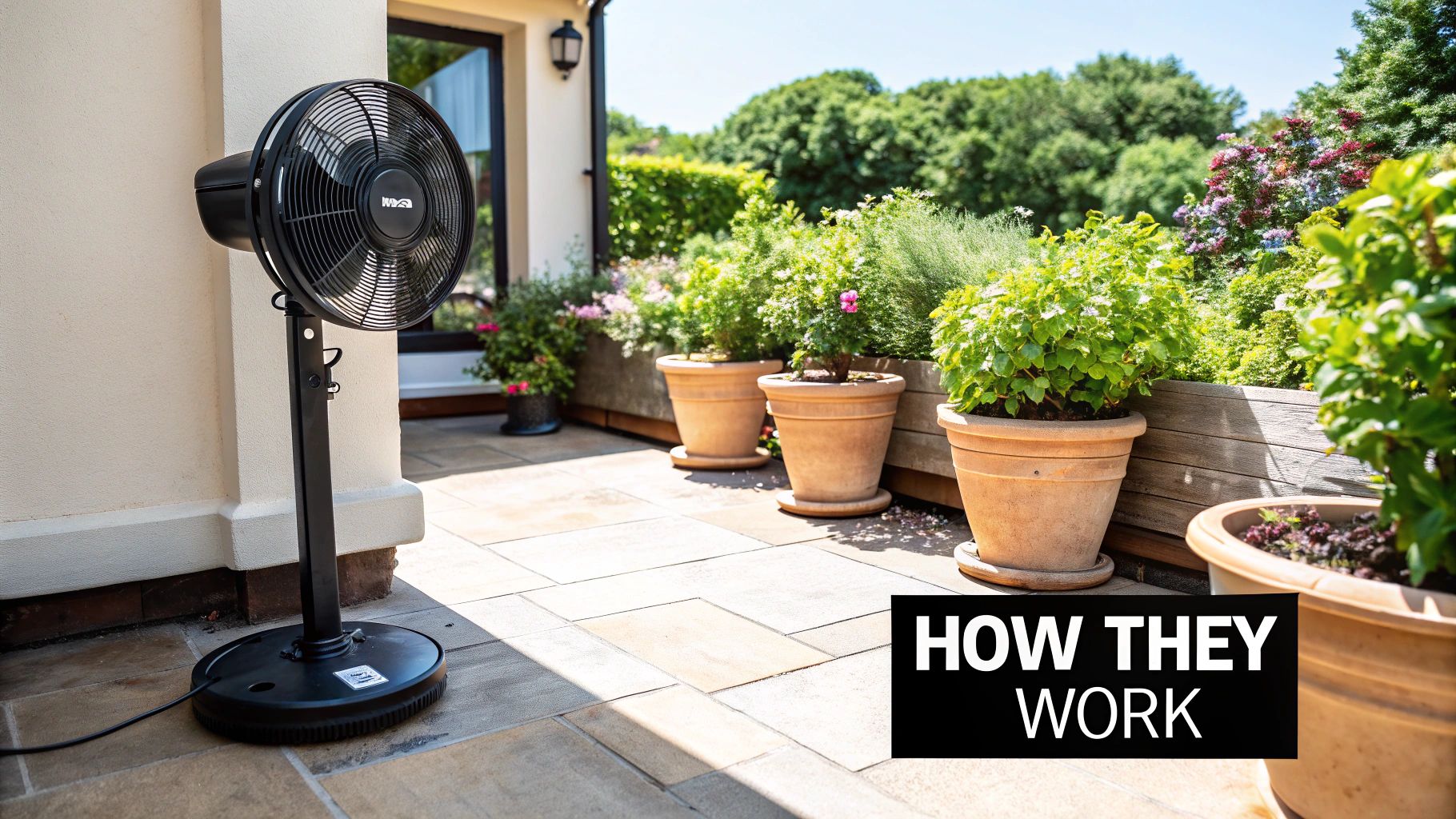
To really get why fly fans work so well, you have to think like a fly. These gadgets aren't magic; they just use clever science to exploit a fly's natural weaknesses.
At its core, the fan's power comes from aerodynamic disruption. Think of a small drone trying to fly through a windstorm. The gentle but constant breeze from the blades creates a pocket of turbulence that's a nightmare for a fly's tiny body.
Flies are nimble, but they just can't handle that kind of localized, chaotic air. This invisible barrier effectively sets up a "no-fly zone" right over your food, forcing them to buzz off and find an easier target. It’s a simple but brilliant way to keep your meal untouched.
Hitting Them Where They See It
But the breeze is only half the story. The best fly fans add a clever visual trick to the mix. Flies have huge, complex compound eyes packed with thousands of lenses, making them incredibly sensitive to light and motion.
This is where the fan's spinning blades, often with holographic or reflective patterns, come into play. They’re designed to mess with a fly’s vision.
As the blades spin, they catch and refract light in a way that looks chaotic to a fly. Its simple brain can't make sense of the constant, shimmering flashes. It just sees a confusing, threatening movement and instinctively flees.
This one-two punch is what makes the whole system so effective. If you want to get into the details, you can learn more about how a fly repellent fan works to see which model is right for you. The bottom line is that the fan creates an area that's both physically impossible and visually terrifying for a fly to enter.
So, the two key principles at play are:
- Air Current Turbulence: The blades create a consistent whirlwind of air that flies are simply too light to push through. It physically blocks them from landing.
- Visual Disturbance: The shiny, holographic patterns on the spinning blades scatter light, creating a confusing and alarming show for a fly's compound eyes. They see it as pure danger.
It's this combination of air and light that makes fly fans such a surprisingly powerful tool. They don’t just shoo flies away—they create a multi-sensory fortress that pests are hardwired to avoid.
Comparing Fly Fans to Other Repellents
When you're trying to keep your space fly-free, it's easy to get overwhelmed by the options. From sticky traps to chemical sprays, every method has its pros and cons. Let's break down how a fly fan stacks up against traditional repellents.
The biggest win for a fly fan is its safety. Aerosol sprays fill the air with chemicals you don't want landing on your food. A fly fan, on the other hand, just uses gentle air movement. This makes it a 100% food-safe solution you can use around kids and pets without a second thought—something you can't say for most chemical-based products.
This is where a fly fan really shines: providing a simple, effective solution right where you need it most.
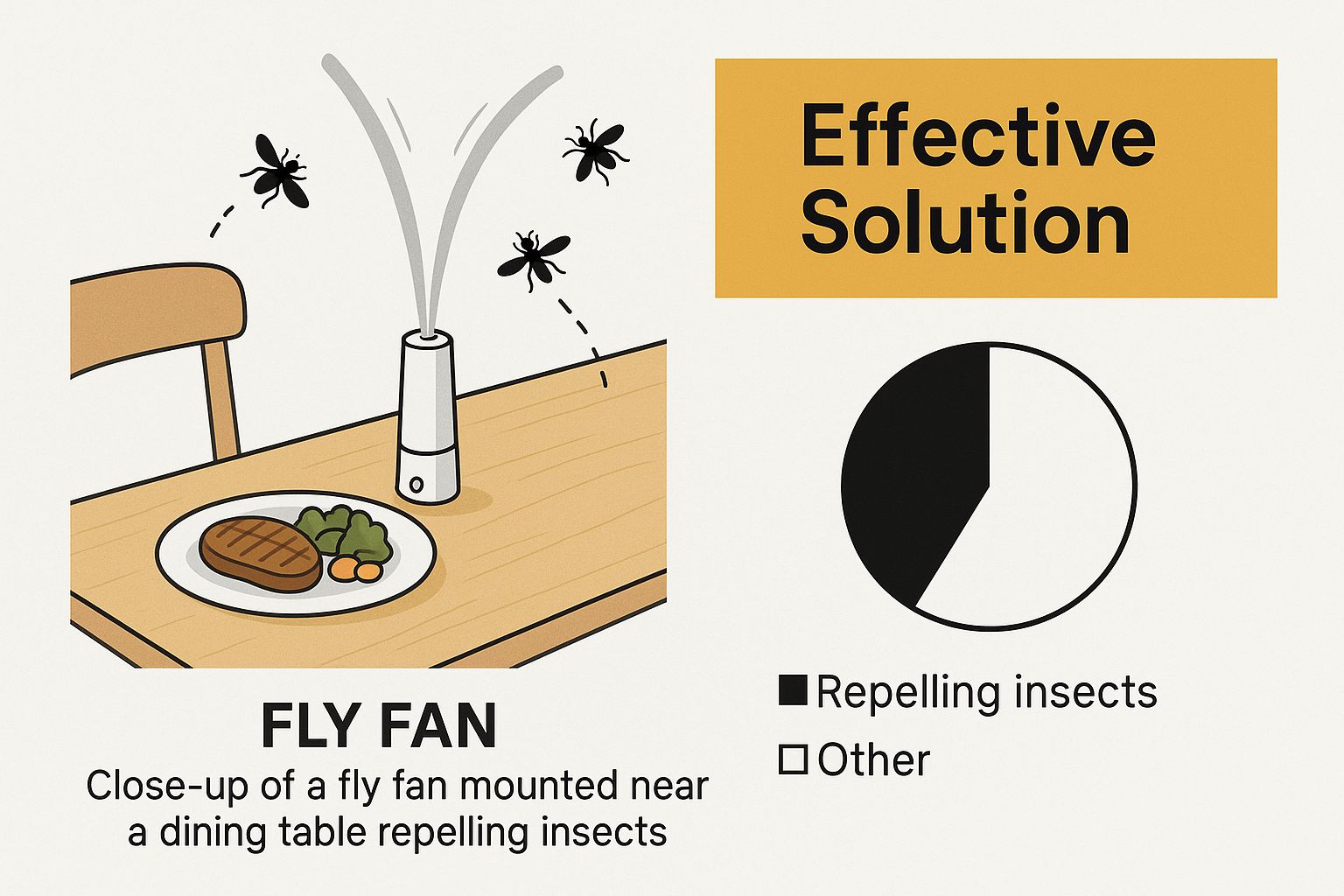
As you can see, a quiet, chemical-free device can create a bug-free bubble without ruining the atmosphere of your meal.
Convenience and Ongoing Costs
Fly fans are also champs when it comes to convenience and reusability. A portable, battery-powered fan is ready to go in seconds, wherever you need it. Compare that to hanging up sticky flypaper, which looks awful and is a one-and-done product you have to keep buying. And let's be honest, who wants to spend their barbecue on high alert with a fly swatter in hand?
While other methods might seem cheaper at first, the repeat purchases really add up. Fly fans are a one-time buy, making them a more sustainable and budget-friendly choice in the long run.
If you’re tired of the mess and hassle that comes with old-school fly control, it’s worth checking out newer approaches. For a deeper dive, you can explore more tips on how to keep flies away from food in our guide.
To make things even clearer, here's a direct comparison of the most popular fly control solutions.
Fly Control Methods Head-to-Head
| Method | Safety | Convenience | Effectiveness | Ongoing Cost |
|---|---|---|---|---|
| Fly Fans | High (chemical-free) | High (portable, reusable) | High (in targeted area) | Low (one-time purchase) |
| Chemical Sprays | Low (toxic fumes) | Medium (quick but messy) | Medium (temporary effect) | High (needs repurchasing) |
| Sticky Traps | Medium (non-toxic but messy) | Low (unsightly, disposable) | Medium (passive capture) | Medium (needs replacing) |
| Fly Swatters | High (no chemicals) | Low (requires manual effort) | Low (only kills one at a time) | Very Low (cheap to buy) |
When you lay it all out, it's clear fly fans offer a unique blend of safety, simplicity, and long-term value that other methods just can't match. They create a silent, effective barrier without the drawbacks of chemicals, mess, or constant effort.
How to Choose the Right Fly Fan
With a bunch of fly fans on the market, how do you pick the right one? It boils down to a few key features. Once you know what to look for, you can be sure you're getting a device that actually does the job.
First, think about the power source. If you're camping or having a picnic, the grab-and-go convenience of a battery-operated model is your best bet. If you're setting up a restaurant patio, a rechargeable USB fan that can charge overnight makes more sense. It all depends on where you'll use it most.
Next is a big one: safety. The best fly fans are built with soft-stop safety blades. These flexible blades are designed to immediately stop spinning the second they touch something—like a child's curious hand. For any family gathering, this feature is a must-have.
Matching the Fan to Your Space
You also have to consider the fan's effective range. A single fan typically covers a bubble about three feet in diameter. That’s perfect for a small café table for two. But if you're hosting a big family barbecue or setting up a long buffet table, you’re going to need more than one.
As a rule of thumb, plan for one fan every two to three feet to keep your table fully protected. This creates an overlapping barrier of air that flies can't sneak through.
Here’s how that looks in a few common scenarios:
- Small Round Table (2-4 people): One fan in the middle should do the trick.
- Standard Rectangular Table (6-8 people): You'll want two fans, spaced evenly, for solid coverage.
- Large Outdoor Event or Buffet: Place a fan every three feet down the line to create a continuous fly-free zone.
The rising popularity of gadgets like fly fans is part of a bigger trend. People are looking for safer ways to deal with pests without spraying chemicals around their food and families. You can read the full research on the growing demand for natural repellents on fortunebusinessinsights.com.
Picking the right model is straightforward once you know your priorities. To see our top picks for different situations, take a look at our guide to the best fly repellent fan.
When and Where Fly Fans Work Best
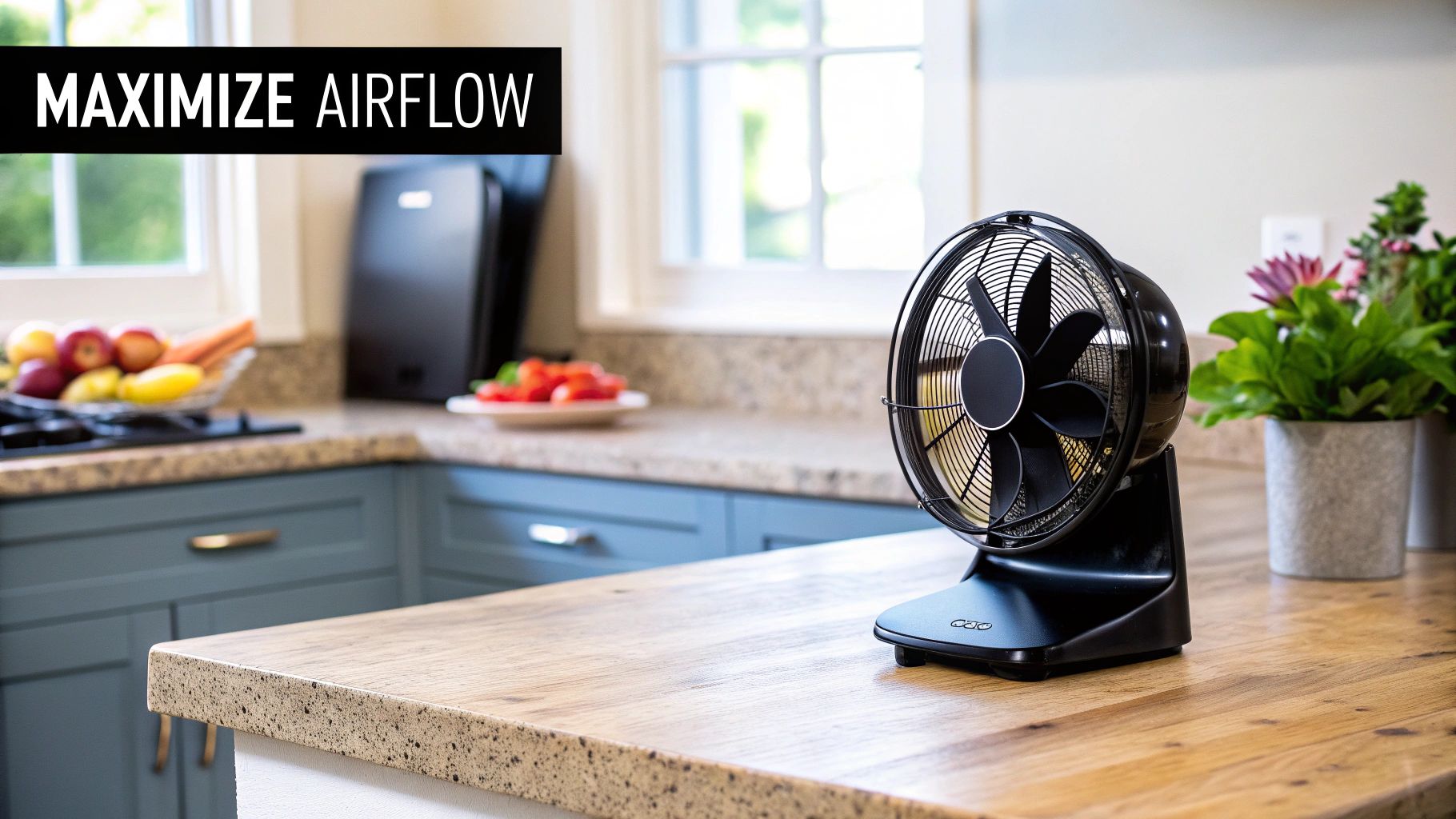
The science behind fly fans is one thing, but seeing them in action is what really makes it click. Let's look at a few real-world situations where these simple gadgets truly shine.
Think about a classic backyard barbecue. The grill is going, drinks are cold, and a beautiful spread of food is laid out. Right on cue, the flies show up. But instead of everyone swatting the air, you have a couple of fly fans quietly spinning over the food, acting as invisible bodyguards.
Suddenly, your guests are enjoying themselves without constantly fanning their plates. The food stays untouched and the vibe stays relaxed. This is what a fly fan is all about: protecting food and preserving the moment.
From Patios to Campsites
This simple idea works just as well in plenty of other spots. Imagine a busy café patio on a sunny day. People are trying to enjoy their lunch, but the flies are ruining it.
Placing a sleek, quiet fan on each table is an instant game-changer. It takes the customer experience from frustrating to fantastic, potentially turning a bad review into a glowing one. Best of all, the fans get the job done without harsh chemicals or distracting noise.
Now, picture yourself on a camping trip. After a great day of hiking, you’re trying to make dinner at your campsite, but it feels like you've invited every fly in the forest. A portable, battery-powered fly fan becomes an absolute lifesaver.
It keeps your prep area clear so you can actually cook and eat in peace. In these situations, a fly fan becomes an essential piece of gear. The mission is always the same: create a small, protected bubble where you can eat, cook, and relax without fighting off pests.
Your Fly Fan Questions, Answered
Even when you get the basic idea behind fly fans, practical questions always come up. It's one thing to know how they work, but another to know how they'll fit into your life. Let's tackle the most common questions.
Will They Be Noisy or Distracting?
This is a top concern, and the answer is a pleasant surprise. Well-made fly fans are incredibly quiet. Their small motors and lightweight blades are engineered to create a gentle, barely-there hum. You can set one in the middle of your dinner table and have a conversation without even noticing it's running.
Are the Spinning Blades Safe Around Kids and Pets?
Yes, they're designed with safety as a top priority. The blades are made of a soft, flexible material with no hard edges. More importantly, most feature a "soft-stop" safety mechanism.
If a curious child's hand or a pet's nose gets in the way, the blades immediately stop spinning on contact. There's no risk of injury, giving you total peace of mind during family gatherings.
The point of a fly fan is to create a relaxing, pest-free zone. That peace of mind has to include knowing it's completely safe for kids and pets at the table.
How Many Fans Do I Actually Need for My Table?
The number of fans you need just comes down to the size of your table. A single fan creates a fly-free bubble that’s about 2-3 feet in diameter.
- For a small round table seating four: One or two fans in the center should be perfect.
- For a long rectangular table: A good rule of thumb is one fan for every four people. This ensures the protected zones overlap, leaving no gaps for flies to sneak through.
Do They Work on Mosquitoes and Other Bugs?
Fly fans are specialists. They are designed specifically to disrupt the flight patterns of flies. While the breeze might bother a mosquito for a moment, these fans are not an effective repellent for them.
Mosquitoes hunt using different senses, like tracking the carbon dioxide you breathe out. A fly fan's gentle air current won't stop them from finding their target.
Ready to reclaim your outdoor meals from pests? Check out the collection of effective and stylish fly fans from MODERN LYFE to find the perfect match for your patio or event. Shop Now at https://modernlyfe.com.

